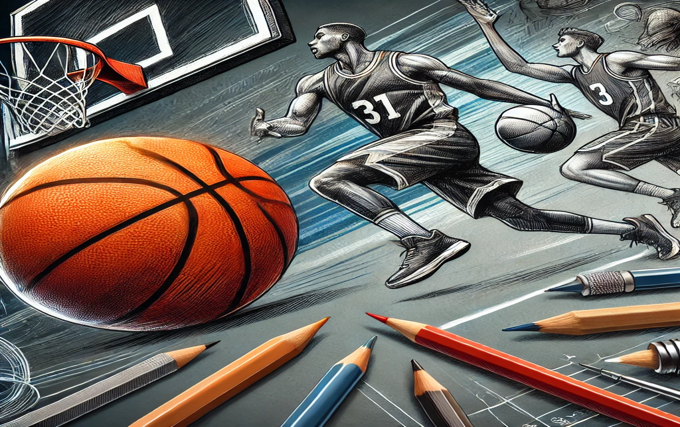Drawing sports scenes, particularly dynamic and action-filled sports like basketball, can be both a rewarding and challenging experience for artists of all skill levels. Whether you are trying to capture the powerful motion of a player dunking, or the precise detailing of a basketball itself, mastering the techniques for drawing basketball-related images can greatly enhance your artistic abilities. This article will dive into various techniques for drawing basketball scenes, players, and equipment, offering useful tips for beginners and advanced artists alike.
Why Drawing Basketball Is So Popular
Basketball, as a fast-paced, high-energy sport, presents a unique challenge for artists. The fluidity of the players’ movements, the interaction between the ball and the court, and the intense moments of competition make for incredible artistic subjects. Whether you’re sketching the tension before a slam dunk or the intricate design of a basketball court, basketball offers endless creative possibilities.
Additionally, basketball has a massive global following. From the NBA in the United States to basketball leagues in Europe and Asia, the sport connects people across different cultures. Drawing basketball scenes not only allows you to tap into a shared love of the game but also to engage with a vast community of sports enthusiasts and artists.
Essential Tools for Drawing Basketball
Before you begin your basketball drawing journey, it’s essential to gather the right tools to bring your artwork to life. The following are the basic materials you might need:
- Sketching Pencils: A range of graphite pencils (from H to B) will allow you to create light outlines and strong, dark strokes.
- Eraser: A high-quality eraser will be necessary for correcting mistakes and lightening areas of the drawing to create highlights.
- Blending Tools: Tools like blending stumps or tissues are great for shading and creating smooth gradients.
- Fine-Liners: For adding details and bold lines, fine-liner pens are perfect, especially if you want to ink your sketches.
- Colored Pencils or Markers: If you want to add color to your basketball drawings, colored pencils or markers can help bring vibrancy to the court, players, and background.
Digital Tools
If you prefer digital drawing, software such as Adobe Photoshop, Procreate, or Clip Studio Paint offers a wide range of brushes and layers to create detailed basketball illustrations. A digital drawing tablet is essential for fluid hand movements and achieving greater control over your strokes.
Step-by-Step Guide to Drawing a Basketball
Drawing a basketball might seem simple at first glance, but to truly capture its texture and depth, you’ll need to pay attention to detail. Follow these steps to create a realistic basketball illustration:
Draw the Basic Shape
Start by sketching a perfect circle using light strokes. If you have trouble drawing circles freehand, using a compass or tracing an object will help you maintain symmetry.
Add Guiding Lines
Next, draw a vertical and horizontal line that intersects at the center of the circle. These lines will act as guides for the sections of the basketball.
Create the Panels
Basketballs are typically divided into several panels. Using the guiding lines, add curved lines that cross each quadrant of the ball. The key is to make these lines slightly curved to give the illusion of a round, three-dimensional object.
Add Texture and Details
Now it’s time to bring your basketball to life by adding texture. Real basketballs are covered in small dots to improve grip. To replicate this texture, you can use stippling (drawing lots of tiny dots) or add small cross-hatching patterns to give the impression of texture.
Shade for Depth
Shading is essential for making your basketball look realistic. Identify the light source and start shading the opposite side of the ball. Use a range of pencil strokes or digital brushes to gradually darken areas, creating a three-dimensional effect.
Add Highlights
Finally, use your eraser to lighten areas where the light would naturally hit the basketball, such as the top edge or the raised panels. These highlights will make the ball appear glossy and round.
Drawing Basketball Players in Action
Drawing basketball players in motion requires a keen understanding of anatomy and dynamic movement. Whether capturing a slam dunk, a fast break, or a defensive stance, the following tips will help you illustrate action-packed basketball scenes:
1. Study Human Anatomy
Understanding the human body is crucial for drawing players in motion. Spend time practicing basic anatomy sketches, focusing on muscles and joints. Pay special attention to how the body moves during physical exertion—basketball is full of leaping, twisting, and sprinting, all of which can be challenging to draw.
2. Capture Motion with Gesture Drawing
Gesture drawing is a technique that involves quickly sketching the movement and posture of a subject. For basketball, gesture drawing helps capture the energy and flow of the game. These quick sketches don’t focus on details but on the overall shape and form of the action. Practice drawing basketball players in different stances—jumping for a rebound, sprinting across the court, or dribbling down the lane.
3. Focus on Clothing and Accessories
When drawing basketball players, remember to include their uniforms, shoes, and other accessories like headbands or knee pads. Pay attention to how clothing folds and stretches during movement, as these details add realism to your drawing.
- Tip: Add the team’s logo or jersey number to make the illustration more personalized.
4. Adding Emotion and Expression
Basketball is an emotional game filled with intensity, and capturing facial expressions is vital to conveying the player’s determination, joy, or frustration. Focus on the eyes, mouth, and overall body language to highlight the emotions that make basketball so compelling to watch.
Creating the Basketball Court
If you want to go beyond just drawing players and balls, illustrating the basketball court itself adds context and atmosphere to your drawing. Follow these guidelines to create an accurate basketball court:
1. Start with Perspective
Perspective drawing is crucial when illustrating a basketball court. Use a two-point perspective to ensure that the court’s lines and hoops shrink toward the horizon. This will help convey depth and make the court look three-dimensional.
2. Court Markings
Accurately depict the lines on the court, including the three-point line, free-throw line, and center circle. These details are important for giving your drawing authenticity.
3. Add Background Elements
You can choose to include elements such as a scoreboard, bleachers with fans, or even banners hanging from the rafters to bring your basketball scene to life. Consider adding shadows from the lights above the court to give the drawing a more realistic feel.
Creative Variations: Cartoon and Stylized Basketball Drawings
Not all basketball drawings need to be hyper-realistic. If you prefer a more stylized approach, you can create fun, exaggerated versions of basketball players or scenes. Consider the following creative options:
- Cartoon Characters: Draw players with oversized heads, exaggerated expressions, or comic-book-style action lines to capture the fun and excitement of the sport.
- Graffiti-Style Basketball Art: Use bold lines, bright colors, and abstract shapes to design basketball-themed artwork inspired by street art and urban culture.
- Minimalist Approach: Simplify your drawings by focusing on the most important elements. A silhouette of a player mid-dunk, for instance, can convey a powerful message with just a few lines.
Tips for Improving Your Basketball Drawings
- Practice Regularly: The key to improving your drawing skills is consistency. Set aside time every week to practice drawing basketballs, players, and courts.
- Use Reference Images: Whether you’re drawing realistic or stylized basketball scenes, reference images are incredibly helpful. Watch basketball games or look up action shots to study body movements, court layouts, and player expressions.
- Experiment with Styles: Don’t be afraid to experiment with different artistic styles. Try using charcoal for a rough, gritty look, or colored markers for a vibrant, energetic feel.
- Seek Feedback: Share your work with other artists or basketball fans for feedback. Constructive criticism can help you see areas for improvement and refine your skills.
Conclusion
Drawing basketball offers an exciting mix of challenges and rewards for artists at all levels. Whether you’re sketching a simple basketball, illustrating a full game in action, or creating a stylized, cartoon version of your favorite player, there’s always something new to explore. By mastering the basics, practicing regularly, and experimenting with creative styles, you can create dynamic, visually captivating basketball art that brings the energy and excitement of the game to life.


